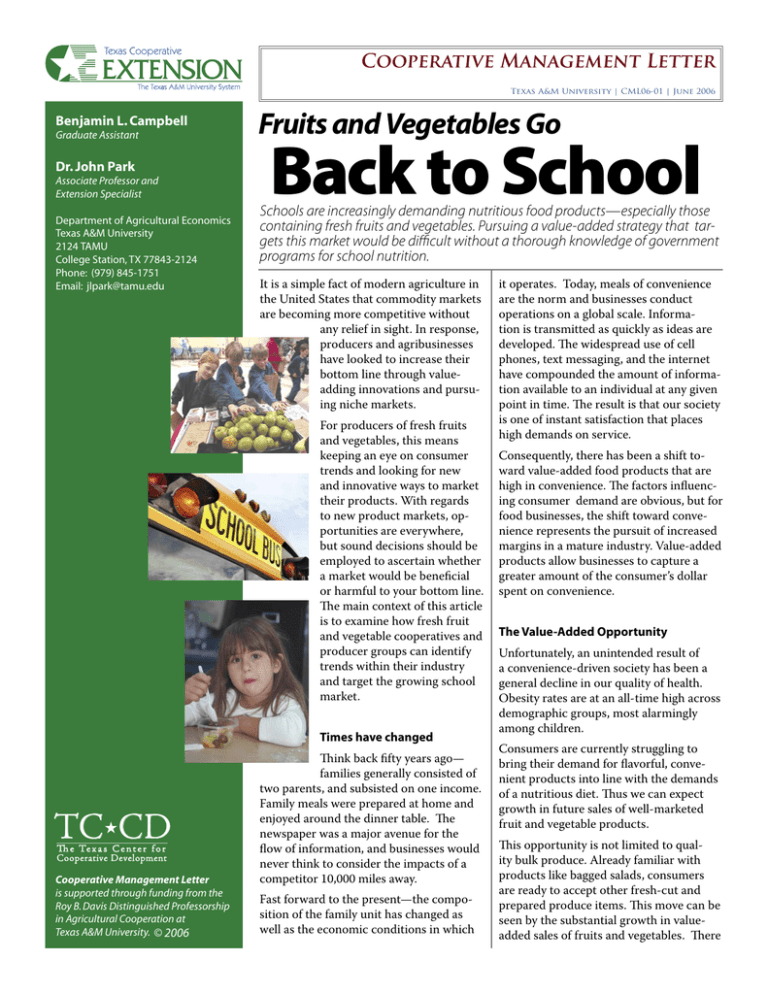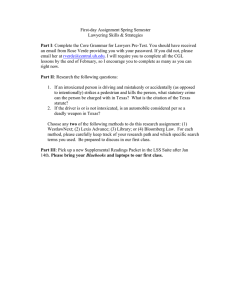Back to School Fruits and Vegetables Go Cooperative Management Letter
advertisement

Cooperative Management Letter Texas A&M University | CML06-01 | June 2006 �������������������� ������������������ ������������� ����������������������� �������������������� ������������������������������������ �������������������� ��������� ������������������������������ ���������������������� ����������������������� Fruits and Vegetables Go Back to School Schools are increasingly demanding nutritious food products—especially those containing fresh fruits and vegetables. Pursuing a value-added strategy that targets this market would be difficult without a thorough knowledge of government programs for school nutrition. It is a simple fact of modern agriculture in the United States that commodity markets are becoming more competitive without any relief in sight. In response, producers and agribusinesses have looked to increase their bottom line through valueadding innovations and pursuing niche markets. For producers of fresh fruits and vegetables, this means keeping an eye on consumer trends and looking for new and innovative ways to market their products. With regards to new product markets, opportunities are everywhere, but sound decisions should be employed to ascertain whether a market would be beneficial or harmful to your bottom line. The main context of this article is to examine how fresh fruit and vegetable cooperatives and producer groups can identify trends within their industry and target the growing school market. Times have changed �� �� � � � �� � � � � � � � � � � � � � � ����������������������� ����������������������������� ������������������������������������� ���������������������������������������� ������������������������������� ��������������������� © 2006 Think back fifty years ago— families generally consisted of two parents, and subsisted on one income. Family meals were prepared at home and enjoyed around the dinner table. The newspaper was a major avenue for the flow of information, and businesses would never think to consider the impacts of a competitor 10,000 miles away. Fast forward to the present—the composition of the family unit has changed as well as the economic conditions in which it operates. Today, meals of convenience are the norm and businesses conduct operations on a global scale. Information is transmitted as quickly as ideas are developed. The widespread use of cell phones, text messaging, and the internet have compounded the amount of information available to an individual at any given point in time. The result is that our society is one of instant satisfaction that places high demands on service. Consequently, there has been a shift toward value-added food products that are high in convenience. The factors influencing consumer demand are obvious, but for food businesses, the shift toward convenience represents the pursuit of increased margins in a mature industry. Value-added products allow businesses to capture a greater amount of the consumer’s dollar spent on convenience. The Value-Added Opportunity Unfortunately, an unintended result of a convenience-driven society has been a general decline in our quality of health. Obesity rates are at an all-time high across demographic groups, most alarmingly among children. Consumers are currently struggling to bring their demand for flavorful, convenient products into line with the demands of a nutritious diet. Thus we can expect growth in future sales of well-marketed fruit and vegetable products. This opportunity is not limited to quality bulk produce. Already familiar with products like bagged salads, consumers are ready to accept other fresh-cut and prepared produce items. This move can be seen by the substantial growth in valueadded sales of fruits and vegetables. There Cooperative Management Letter | June 2006 | 2 are, however, advantages and disadvantages to expanding an existing product line to encompass a new value-added product. Advantages throughout the state. This is a very stable market that requires fresh fruit and vegetables weekly due to government regulations. Most (if not all) school districts have a food service director that is in charge of purchasing foods for the students within the district. The main meal includes lunch, but other optional meals include breakfast and snacks. The general procedure for purchasing produce is as follows: • Improved gross margins • Access to new markets Disadvantages • Increased cost and complexity of operations • Increased requirements of fixed assets and expertise • Success requires consistency in product quality that may be difficult to achieve throughout the season USDA Value-Added Producer Grants Agricultural producers and producer groups (including cooperatives) in the United States can access grant money available through USDA-Rural Development to assist with starting a value-adding activity. • Money for planning market potential or feasibility of value-added agricultural products • Money for operating capital for new value-adding activities • Grant applications are typically due in March, and can take from 6-8 weeks to prepare Hitting the School Market New markets exist for most all products if we look in the right places. For example, a natural market for fruit and vegetable cooperatives to market their produce is school districts 1) Schools place orders for fruit and vegetables with district food director. 2) Directors combine all school orders to form a master list 3) Fruit are then purchased differently depending on payment type (i.e. district monies, government programs like the National School Lunch Program, etc.) Government Programs The National School Lunch Program (NSLP) is the major government program that food directors use to purchase their lunch foods. The NSLP encompasses two sub-programs that are of specific interest to Texas fruit and vegetable cooperatives: the Texas Farm to School Program and the Fresh Fruit and Vegetable Program. Those programs are described here. Texas Farm to School • Administered by Texas Department of Health and Human Services (TDHHS) with help from the Texas Department of Agriculture (TDA) • Only fruit grown in Texas are eligible • Food director can use up to 6% of their NSLP monies in this program ������������������������������� ����������������� ��������������� ���������������� ������������� ������ ���������������� ����� �� ���������������������� �������� �� ���������������������� �������� ���������������� ���������� ������������� ���������������� �� ���������������������� ���������������� �� �������������������������� ��������������������������� ������ �������������� ����������������� ���������� �������������� �� ���������������������� ���������������������������� ������� ����� ���������������� Cooperative Management Letter | June 2006 | 3 • Inner Workings: • District places order with TDHHS • TDHHS tries to find, with the help of TDA, Texas growers to fill the order • Once order is found it is shipped to one of several warehouses throughout the state and is then distributed to the district Fresh Fruit and Vegetable Program • Administered by Department of Defense (DOD) • Food directors may only purchase from certified (by DOD) vendors For More Information Check out http://www.rurdev.usda.gov/rbs/coops/vadg.htm for more information on the USDA Value-Added Development Grant program. Contact the Texas Department of Health and Human Services or the Texas Department of Agriculture for more information regarding the Texas Farm-to-School Program or visit http://www.fns.usda.gov/cnd/lunch/ for information from USDA on National School Lunch Program and farm-to-school programs nationwide. • Food Director can use up to 100% of NSLP monies in this program • Inner Workings: • District sends out bid sheets to certified vendors • Vendors send back bids for each commodity on the list • Lowest bid wins and must deliver fruit as director specifies • Problems for coops: • Potential suppliers must be able to supply all products on the bid sheet, not just the commodity handled by the cooperative • Commodities must be delivered to each school in a district or a central distribution point, which could be costly These government programs provide easily accessible markets that cooperatives can take advantage of to increase sales. These programs exist for most all commodities and can usually be found by searching the internet or contacting TDA for information. Before entering a new market or taking part in a governmental program, the advantages and disadvantages should be analyzed in order to account for hidden costs, such as delivery charges, which can vary and are negotiable. Marketing to school programs is just one example for valueadded produce, but opportunities for other commodities and other markets can be discovered as well. By keeping up with the changes in an industry and the watching for new markets, agricultural producers and their cooperative businesses can increase sales and expand markets. �� �� � � � �� � � � � � � � � � � � � � � ����������������������� Educational programs of Texas Cooperative Extension are open to all people without regard to race, color, sex, disability, religion, age, or national origin. Issued in furtherance of Cooperative Extension Work in Agriculture and Home Economics, Acts of Congress of May 8, 1914, as amended, and June 30, 1914, in cooperation with the United States Department of Agriculture, Edward G. Smith, Director, Texas Cooperative Extension, The Texas A&M University System.





